Vicksburg & More
Prev
Next
|
Day 5: December 27, 2006 Vicksburg & More |
Prev Next |
|
|
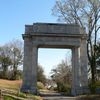
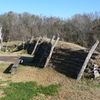
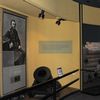
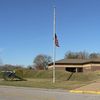 I started the day by heading directly to the
Vicksburg National
Military Park. First stop was the Visitor Center where an eighteen
minute video and a small museum are available. Note the flag at half mast
to mark yesterday's death of President Ford. Then, after looking over some
of the center's defenses, it was through the arch for a sixteen mile
driving tour of the battle field. Ride-along guides can be hired at the
Visitor Center and CDs & cassettes are available to accompany the
drive. I believe guides started at $40, CDs were around $10 and cassettes
less.
I started the day by heading directly to the
Vicksburg National
Military Park. First stop was the Visitor Center where an eighteen
minute video and a small museum are available. Note the flag at half mast
to mark yesterday's death of President Ford. Then, after looking over some
of the center's defenses, it was through the arch for a sixteen mile
driving tour of the battle field. Ride-along guides can be hired at the
Visitor Center and CDs & cassettes are available to accompany the
drive. I believe guides started at $40, CDs were around $10 and cassettes
less.
|
|
|
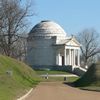
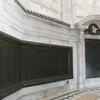
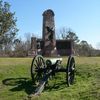
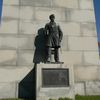
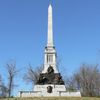
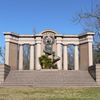 The only thing I recognized in the park was the Illinois monument. I
didn't actually recognize it as the Illinois monument but I had seen
pictures of it associated with the battlefield. I don't recall seeing
inside it, however. Over half of the Union soldiers participating in the
battle were from Illinois. The Missouri monument also caught my eye.
The only thing I recognized in the park was the Illinois monument. I
didn't actually recognize it as the Illinois monument but I had seen
pictures of it associated with the battlefield. I don't recall seeing
inside it, however. Over half of the Union soldiers participating in the
battle were from Illinois. The Missouri monument also caught my eye.
I was a little surprised to see a statue of David Farragut but only for a moment. The Navy was heavily involved in the battle from the nearby river. When the battle was fought, that river was the Mississippi but not so today. The Mississippi "moved", by cutting off a meander, in 1876. The Army Corps of Engineers diverted the Yazoo River past the city in 1903. Monuments for individuals and various groups abound. The state monuments are the biggest. I've pictured the Mississippi and Texas monuments for the home team. Illinois & Missouri were with the visitors. |
|
|

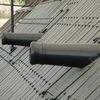
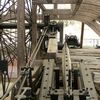
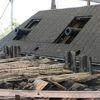
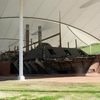 In December of 1862, the
USS Cairo became the first ship ever sunk
by electrically discharged torpedoes. Today these devices would be called
mines but they were called torpedoes in those days and were the very
things Admiral Farragut was referring to with his "Damn the
torpedoes, full speed ahead" when he charged into Mobile Bay just
about a month after the surrender of Vicksburg.
In December of 1862, the
USS Cairo became the first ship ever sunk
by electrically discharged torpedoes. Today these devices would be called
mines but they were called torpedoes in those days and were the very
things Admiral Farragut was referring to with his "Damn the
torpedoes, full speed ahead" when he charged into Mobile Bay just
about a month after the surrender of Vicksburg.
In 1956, the Cairo was located and she was raised, although not in one piece, in the mid-1960s. Today the partially reconstructed boat can be seen at the park along with many recovered artifacts. |
|
|
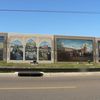
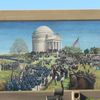
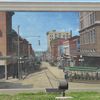 The Vicksburg flood wall is providing space for another series of
Robert Dafford murals. I've seen those in Covington
and Maysville, Kentucky, and in Portsmouth, Ohio, and they all impress.
The Vicksburg flood wall is providing space for another series of
Robert Dafford murals. I've seen those in Covington
and Maysville, Kentucky, and in Portsmouth, Ohio, and they all impress.
|
|
|
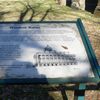
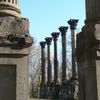
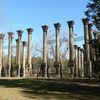
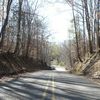 I headed back to Port Gibson (Where I discovered that the motel I thought
closed, isn't.) and followed the rather pleasant Rodney Road to the
ruins of Windsor. The mansion survived the war,
including an encampment by some of Grant's troops, then died in 1890 from
second hand fire from a misplaced cigarette.
I headed back to Port Gibson (Where I discovered that the motel I thought
closed, isn't.) and followed the rather pleasant Rodney Road to the
ruins of Windsor. The mansion survived the war,
including an encampment by some of Grant's troops, then died in 1890 from
second hand fire from a misplaced cigarette.
|
|
|
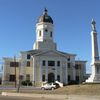
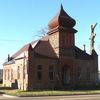
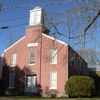

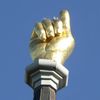 The town "too beautiful to burn" does have some very attractive
buildings. Pictured here are the Claiborne County courthouse, the Temple
Gemiluth Chassed, the Brashear Academy, and the First Presbyterian Church.
The church, one of many on appropriately named Church Street, is almost a
town trademark. Zebulon Butler, the church's founder and first pastor, so
frequently used a skyward pointing finger to emphasis a point that the
congregation chose that, rather than a cross, to top their church. The
current gilded hand is a replacement for the badly deteriorated original.
The town "too beautiful to burn" does have some very attractive
buildings. Pictured here are the Claiborne County courthouse, the Temple
Gemiluth Chassed, the Brashear Academy, and the First Presbyterian Church.
The church, one of many on appropriately named Church Street, is almost a
town trademark. Zebulon Butler, the church's founder and first pastor, so
frequently used a skyward pointing finger to emphasis a point that the
congregation chose that, rather than a cross, to top their church. The
current gilded hand is a replacement for the badly deteriorated original.
As I looked at the close up of the hand, I saw something resembling hair on Reverend Butler's immortalized knuckles. "Just how realistic is this thing?", I wondered. I looked at a shot from the other side and could see that there is, in fact, something (grass? moss?) growing on the hand. That other, sun bleached view, is here. |
|
|
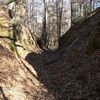
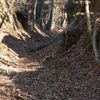
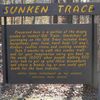 Back on the Natchez Trace Parkway, the first stop was at another bit of
"sunken trace". This example is deeper and narrower than the one
I saw yesterday and can easily be walked from one end to the other.
Walking through what is essentially a roofless tunnel is rather eerie.
Doing that for mile after mile knowing that thieves, Indians, and hungry
critters could be just above you could sure be discomforting.
Back on the Natchez Trace Parkway, the first stop was at another bit of
"sunken trace". This example is deeper and narrower than the one
I saw yesterday and can easily be walked from one end to the other.
Walking through what is essentially a roofless tunnel is rather eerie.
Doing that for mile after mile knowing that thieves, Indians, and hungry
critters could be just above you could sure be discomforting.
|
|
|
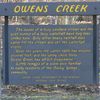
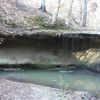
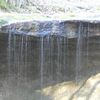
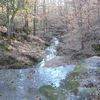 My expectations were sufficiently lowered by the sign and by guide books
that I was happy to see and hear any amount of water coming off of the
rock ledge. That same fellow who recommended Longwood as Natchez's number
one mansion, also recommended this stop on the Trace. He had not traveled
the Trace above Jackson but, of that portion, this was the only spot he
thought enough of to mention. He stressed that it was "right
there"; No hiking required. I imagine most people he made the
recommendation to were leery of anything that took them far from their car
and he had no way of knowing that I would likely stop at almost every pull
off I came to.
My expectations were sufficiently lowered by the sign and by guide books
that I was happy to see and hear any amount of water coming off of the
rock ledge. That same fellow who recommended Longwood as Natchez's number
one mansion, also recommended this stop on the Trace. He had not traveled
the Trace above Jackson but, of that portion, this was the only spot he
thought enough of to mention. He stressed that it was "right
there"; No hiking required. I imagine most people he made the
recommendation to were leery of anything that took them far from their car
and he had no way of knowing that I would likely stop at almost every pull
off I came to.
|
|
|
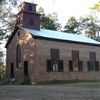
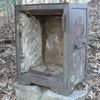
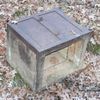
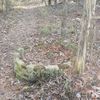
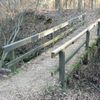 With sunset coming at 5:03, I was becoming a little concerned about
getting in this stop and short hike and it was fairly high on my list. A
town of over 2000 once thrived here but only a church and a pair of safes
remain. This was the town of Rocky Springs and the safes were mentioned in
every description I've found. I really wanted to see those safes.
With sunset coming at 5:03, I was becoming a little concerned about
getting in this stop and short hike and it was fairly high on my list. A
town of over 2000 once thrived here but only a church and a pair of safes
remain. This was the town of Rocky Springs and the safes were mentioned in
every description I've found. I really wanted to see those safes.
Mission accomplished with enough daylight left to find a sleeping spot near Jackson. |
|
|
| [Prev] [Site Home] [Home] [Contact] [Next] |